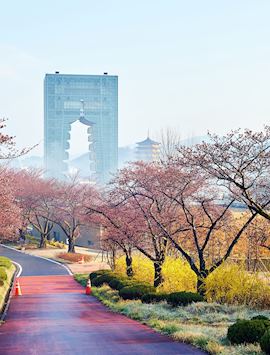
The imperial capital of the Silla Dynasty for almost 1,000 years, Gyeongju is one of South Korea’s most historically significant cities — its many temples, royal tombs, palaces and pagodas demonstrate a sophisticated understanding of everything from astronomy to engineering. Exploring the region with a local guide offers a chance to learn about this remarkable period in Korean history, which lasted from 57 BC to 935 AD, and to understand its importance and lasting influence in terms of the political, architectural and academic history of the country.
Many of the city’s buildings, including temple complexes, palaces and a royal observatory, are protected as UNESCO World Heritage Sites. As you visit, you’ll be able to piece together the evolution of the dynasty over its long history, its role as a cultural hub for the whole country and the influence of Buddhist and Confucian philosophy on its rulers, residents and buildings.
Your guide will meet you at your hotel on the morning of your tour, driving you out to see some of the historical and natural sights of the Gyeongju area and teaching you a little about the region’s history and culture as you go.
Your first stop is likely to be the Bulguksa Royal Temple Complex, a UNESCO World Heritage Site that’s considered to be one of the finest temples on the Korean Peninsula. Considered a masterpiece of Silla architecture and artwork, it was constructed in the 8th century and is elaborately painted and decorated. Your guide will help you to understand the significance of Buddhist and Confucian philosophy, traditional Korean numerology and feng shui in the design and construction of the temple.
From Bulguksa, drive up the mountain ridge behind the temple to Seokguram, a Buddhist grotto and World Heritage Site dating back to the 8th century. After you see the temple, ceremonial bell and the sweeping views, your guide will explain the importance of Gyeongju’s role as a cultural hub during the Silla Dynasty and its significance in this period of Korea’s history.
Stop at a local restaurant for lunch then move on to the Gyeongju Folk Hand Craft Village, established in the 1980s as an effort to preserve and promote traditional Silla-era crafts. Some of the country’s most respected potters, woodworkers and metalworkers have their workshops here in a collection of traditional thatched and tiled houses. You may be able to see some demonstrations of the traditional techniques involved, and although the craftworks are for sale, there’s no pressure to make a purchase.
From here, continue on to the Bunhwangsa Temple Complex on the outskirts of the city. Although only some of the original 7th-century buildings remain, even the ruins tell a complex story about the early history of Korea. One of the most impressive buildings is a brick pagoda protected by a series of finely carved guardian stones.
Continue on to the ruins and excavation site of the Silla Royal Palace, where you can learn more about this period of history. Finally, visit the nearby 7th-century Cheomseongdae Observatory, the oldest surviving astronomical observatory in Asia, where the construction reflects a sophisticated understanding of planetary movements.
who's been there
-
617-223-4521617-223-4901
- Make an inquiry
Photos of Highlights of Gyeongju tour
Experience it for yourself
You can enjoy this activity as part of the suggested tours below, or we can weave it into a trip shaped entirely around you.





